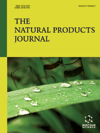- Home
- A-Z Publications
- Natural Products Journal, The
- Previous Issues
- Volume 6, Issue 2, 2016
Natural Products Journal, The - Volume 6, Issue 2, 2016
Volume 6, Issue 2, 2016
-
-
Phytochemistry and Biological Activity Perspectives of Rheum Species
More LessAuthors: Pramod Singh, Geeta J. nee Pant and MSM RawatThe genus Rheum is a member of the family Polygonaceae. Rheum species, generally known as Rhubarb growing in high altitude, are important medicinal herbs containing secondary metabolites and grow in India, China, Korea, and Japan. Several chemical constituents from Rheum species are pharmacologically important. Besides being used as herbal medicine and also used in the vegetables and for making natural dyes. Read More
-
-
-
New Anthocyanins from Black Elderberry of Inhibitory Potential Revealed by Mass Spectrometry
More LessAuthors: Simin D. Maleknia and Kevin M. DownardBackground: A resurgent interest in the use of natural product based inhibitors against the influenza virus has resulted from the widespread resistance to current antiviral therapeutics among circulating strains. Natural products derived from food sources in particular, offer the benefit of a safer pharmacological profile and may offer broader health benefits. Objective: To identify new anthocyanins from black elderberry (S Read More
-
-
-
Sesquiterpenoids from Eupatorium Serotinum
More LessAuthors: Jason A. Clement and Timothy J. WillisEupatorium serotinum Michx. (late thoroughwort, Asteraceae) is a perennial herbaceous plant that is common to the eastern United States. The plant has diaphoretic effects, and has a folk remedy usage as a fever reducer. Relatively little is known about the chemistry of this plant. To better understand the chemistry of this plant and for the identification of taxonomic markers for the plant, we have isolated three sesquiterpen Read More
-
-
-
Screening of Potential Anticancer Compounds from Sargassum wightii to Target Breast Cancer Specific HER2 Receptor using in-silico Analysis
More LessAuthors: P. Balachandran, T. V. Ajay Kumar and V. ParthasarathyThe present research focuses on the molecular docking analysis of the isolated compound from the seaweed “Sargassum wightii” on cancer specific HER2 or HER2/neu also known as CD340. The ethanol derived compounds capable of binding to HER2 receptor is implicated for the breast cancer. The crystal structure of the HER2 protein with the resolution of 1.63Ao (Pdb entry 4RJ3) collected from the pdb website (www.pd Read More
-
-
-
LC-HRMS and NMR Analysis of Lyophilized Acmella oleracea Capitula, Leaves and Stems
More LessLyophilized Acmella oleracea capitula, leaves and stems were extracted with methanol at 100 °C and 10 MPa (100 atm) pressure in a sealed container and analyzed by LC-HRMS and NMR. This solubilized 28.3% of the leaves, 24.7% of the stems and 31.1% of the capitula. The NMR spectra were dominated by signals due to the CHO and CH2O of carbohydrates. Spilanthol and other Nalkamides were present in the methanoli Read More
-
-
-
Herbal Formulation Against Dental Caries Causing Microorganisms Using Extracts of Stevia Rebaudiana Leaves (A Natural Sweetner)
More LessAuthors: Ridhi Mehta, Ram Kumar Pundir, Dhanashree Sakhare and Anil K. SharmaStevia Rebaudiana leaves have functional and sensory properties superior to those of many other high-potency sweeteners. Dental caries is an infectious microbiological disease that affects almost every human. There is a linear correlation of sugar consumption with dental caries in populations worldwide. Present invention was directed to design and develop Stevia based polyherbal formulation with enhanced perfor Read More
-
-
-
Isolation of Heraclenin from Aegle marmelos correa and Screening for its Antimicrobial Activity Through in vitro & in silico Studies
More LessAuthors: V. P. Santhana Krishnan, G. Karthikeyan, P. Janaki, B. Poonkodi and R. SathyaImperatorin, Heraclenin and Auraptene were isolated from the fruit pulp of Aegle marmelos correa. The structure of these compounds was confirmed by spectroscopic and single X-ray analysis. Among them Heraclenin crystallized out in large from the fruit pulp oil without further purification by conventional chromatographic techniques. The anti-microbial activity was performed on Xanthomonas oryzae pv. Oryzae Read More
-
-
-
Study of Grumixama (Eugenia Brasiliensis, Lam) Fruit Pulp and Development of a Jelly: Rheological, Sensorial and Colorimetric Evaluation
More LessA jelly prepared from Eugenia brasiliensis fruit pulp was developed and evaluated for its rheological and sensorial properties, as well as its color. The fruit pulps were acidic (0.29±0.03 g citric acid equiv•100g-1 pulp) and contained 95.29±0.03% water, soluble solids (5°Brix), proteins (0.27±0.17%), lipids (0.13±0.02%) and a relatively low energy content (35.16 kcal). Several minerals were quantified. Here are the amo Read More
-
-
-
Repeated dose Toxicity Study in Rats of the Formulation Containing Metformin and Sitagliptin using Microwave Assisted Acrylamide Grafted Cassia tora as Polymer
More LessAuthors: Shubhasis Dan, Nilendra Chatterjee, Pallab Mandal, Anjan Das, Balaram Ghosh and Tapan Kumar PalUsage of excipients from natural sources is now the most attractive research areas. Most of the synthetic polymers used in the formulation are detrimental to some extent for the human physiological system. Herbal substitute will be the best choice to minimize long term adverse effect. The purposes of repeated dose toxicity testing are to obtain information about biologic activity of chemicals. In the present study, repeated Read More
-
Most Read This Month
Article
content/journals/npj
Journal
10
5
false
en


